Warsaw Pact
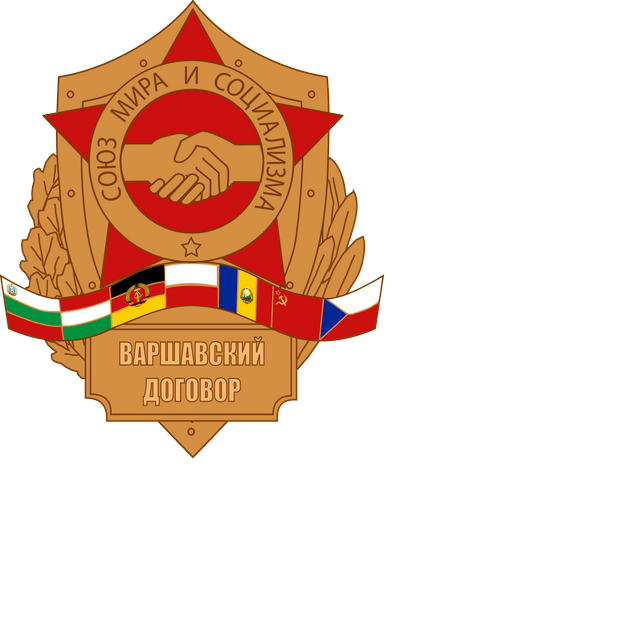
Warsaw Pact

| Abbreviation | WAPA |
|---|---|
| Founded | 14 May 1955 |
| Founded at | Warsaw, Poland |
| Dissolved | 1 July 1991 |
| Type | Military alliance |
| Headquarters | Moscow, Soviet Union |
| Affiliations | Council for Mutual Economic Assistance |
The Warsaw Pact, formally known as the Treaty of Friendship, Cooperation and Mutual Assistance,[2] was a collective defence treaty signed in Warsaw, Poland between the Soviet Union and seven Eastern Bloc satellite states of Central and Eastern Europe in May 1955, during the Cold War. The Warsaw Pact was the military complement to the Council for Mutual Economic Assistance (CoMEcon), the regional economic organization for the socialist states of Central and Eastern Europe. The Warsaw Pact was created in reaction to the integration of West Germany into NATO[3][4][5][6] in 1955 per the London and Paris Conferences of 1954,[7][8][9][10][11] but it is also considered to have been motivated by Soviet desires to maintain control over military forces in Central and Eastern Europe.[12]
The Warsaw Pact was established as a balance of power[13] or counterweight[14] to NATO; there was no direct military confrontation between them. Instead, the conflict was fought on an ideological basis and in proxy wars. Both NATO and the Warsaw Pact led to the expansion of military forces and their integration into the respective blocs.[14] Its largest military engagement was the Warsaw Pact invasion of Czechoslovakia in August 1968 (with the participation of all Pact nations except Albania, Romania, and East Germany),[13] which, in part, resulted in Albania withdrawing from the pact less than a month later. The Pact began to unravel in its entirety with the spread of the Revolutions of 1989 through the Eastern Bloc, beginning with the Solidarity movement in Poland[15] and its electoral success in June 1989.
East Germany withdrew from the Pact following the reunification of Germany in 1990. On 25 February 1991, at a meeting in Hungary, the Pact was declared at an end by the defence and foreign ministers of the six remaining member states. The USSR itself was dissolved in December 1991, although most of the former Soviet republics formed the Collective Security Treaty Organization shortly thereafter. Throughout the following 20 years, the seven Warsaw Pact countries outside the USSR each joined NATO (East Germany through its reunification with West Germany; and the Czech Republic and Slovakia as separate countries), as did the three Baltic states (Estonia, Latvia, and Lithuania) that had been part of the Soviet Union.
| Abbreviation | WAPA |
|---|---|
| Founded | 14 May 1955 |
| Founded at | Warsaw, Poland |
| Dissolved | 1 July 1991 |
| Type | Military alliance |
| Headquarters | Moscow, Soviet Union |
| Affiliations | Council for Mutual Economic Assistance |
Nomenclature
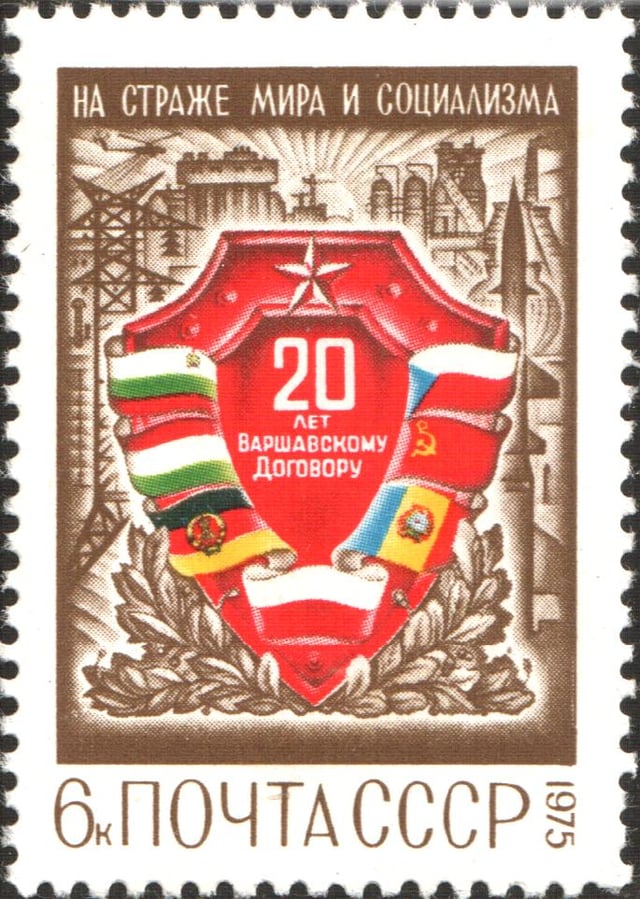
A Soviet philatelic commemoration of the 20th anniversary of the Warsaw Pact in 1975 stating that it remains "On guard for Peace and Socialism".
In the Western Bloc, the Warsaw Treaty Organization of Friendship, Cooperation and Mutual Assistance is often called the Warsaw Pact military alliance—abbreviated WAPA, Warpac and WP. Elsewhere, in the former member states, the Warsaw Treaty is known as:
Albanian: Pakti i miqësisë, bashkëpunimit dhe i ndihmës së përbashkët
Armenian: Բարեկամության, համագործակցության եւ փոխադարձ օգնության պայմանագիր Romanized Armenian: Barekamut’yan, hamagortsakts’ut’yan yev p’vokhadardz ognut’yan paymanagir
Azerbaijani: Dostluq, Əməkdaşlıq və qarşılıqlı yardım müqaviləsi
Belarusian: Дагавор аб дружбе, супрацоўніцтве і ўзаемнай дапамозе Romanized Belarusian: Dagavor ab druzhe, supratsoŭnitstve i ŭzaemnaŭ dapamoze
Bulgarian: Договор за дружба, сътрудничество и взаимопомощ Romanized Bulgarian: Dogovor za druzhba, satrudnichestvo i vzaimopomosht
Czech: Smlouva o přátelství, spolupráci a vzájemné pomoci
Slovak: Zmluva o priateľstve, spolupráci a vzájomnej pomoci
Estonian: Sõprus, koostöö ja vastastikune abi
Georgian: მეგობრობის, თანამშრომლობისა და ურთიერთდახმარების ხელშეკრულება Romanized Georgian: megobrobis, tanamshromlobisa da urtiertdakhmarebis khelshek’ruleba
German: Vertrag über Freundschaft, Zusammenarbeit und gegenseitigen Beistand
Hungarian: Barátsági, együttműködési és kölcsönös segítségnyújtási szerződés
Kazakh: Достық, ынтымақтастық және өзара көмек туралы келісім Romanized Kazakh: Dostıq, ıntımaqtastıq jäne özara kömek twralı kelisim
Kyrgyz: Достук, кызматташтык жана өз ара жардам көрсөтүү жөнүндө келишим Romanized Kyrgyz: Dostuk, kızmattaştık jana öz ara jardam körsötüü jönündö kelişim
Latvian: Līgums par draudzību, sadarbību un savstarpēju palīdzību
Lithuanian: Draugystės, bendradarbiavimo ir savitarpio pagalbos sutartis
Polish: Układ o przyjaźni, współpracy i pomocy wzajemnej
Romanian: Tratatul de prietenie, cooperare și asistență mutuală
Russian: Договор о дружбе, сотрудничестве и взаимной помощи Romanized Russian: Dogovor o druzhbe, sotrudnichestve i vzaimnoy pomoshchi
Tajik: Шартномаи дӯстӣ, ҳамкорӣ ва кӯмаки мутахассис Romanized Tajik: Şartnomai dūstī, hamkorī va kūmaki mutaxassis
Turkish: Dostluk Antlaşması, İşbirliği ve Karşılıklı Yardımlaşma
Ukrainian: Договір про дружбу, співробітництво і взаємну допомогу Romanized Ukrainian: Dogovir pro druzhbu, spivrobitnitstvo i vzaêmnu dopomogu
Uzbek: Do'stlik, hamkorlik va o'zaro yordam shartnomasi
Structure
The Warsaw Treaty's organization was two-fold: the Political Consultative Committee handled political matters, and the Combined Command of Pact Armed Forces controlled the assigned multi-national forces, with headquarters in Warsaw, Poland. Furthermore, the Supreme Commander of the Unified Armed Forces of the Warsaw Treaty Organization which commanded and controlled all the military forces of the member countries was also a First Deputy Minister of Defence of the USSR, and the Chief of Combined Staff of the Unified Armed Forces of the Warsaw Treaty Organization was also a First Deputy Chief of the General Staff of the Armed Forces of the USSR. Therefore, although ostensibly an international collective security alliance, the USSR dominated the Warsaw Treaty armed forces.[16]
Strategy
The strategy behind the formation of the Warsaw Pact was driven by the desire of the Soviet Union to dominate Central and Eastern Europe. The Soviets wanted to keep their part of Europe and not let the Americans take it from them. This policy was driven by ideological and geostrategic reasons. Ideologically, the Soviet Union arrogated the right to define socialism and communism and act as the leader of the global socialist movement. A corollary to this idea was the necessity of intervention if a country appeared to be violating core socialist ideas and Communist Party functions, which was explicitly stated in the Brezhnev Doctrine.[17] Geostrategic principles also drove the Soviet Union with the desire to create a buffer zone to prevent invasion of its territory by Western European powers.
Notable military exercises
"Szczecin]" (Poland, 1962)
"Vltava" (Czechoslovakia, 1966)
Operation "Rhodope" (Bulgaria, 1967)
"Oder-Neisse" (East Germany, 1969)
Przyjaźń 84 (Poland, 1984)
Shield 84' (Czechoslovakia, 1984)[18]
History
Beginnings
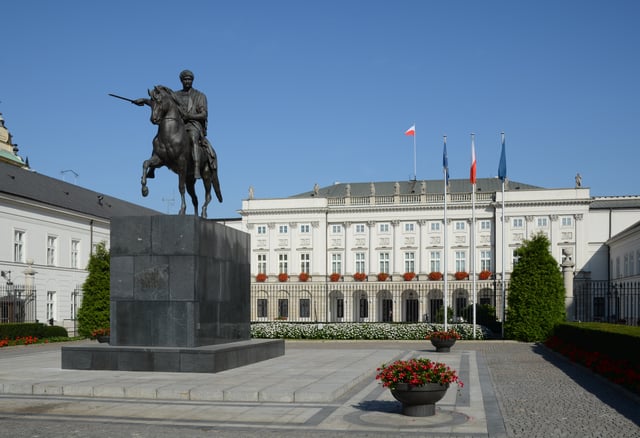
The Presidential Palace in Warsaw, Poland, where the Warsaw Pact was established and signed on 14 May 1955
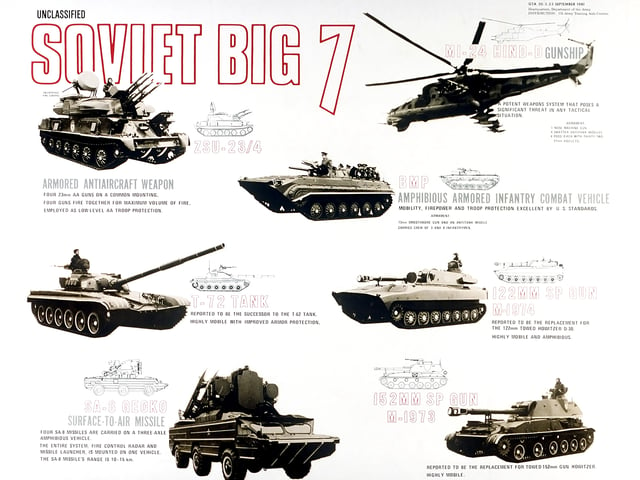
Warsaw Pact "Big Seven" threats displaying the equipment of the communist forces
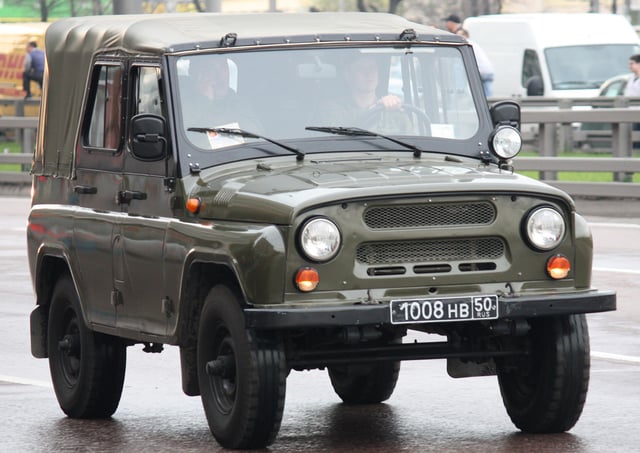
A typical Soviet military jeep UAZ-469, used by most countries of the Warsaw Pact
Before the creation of the Warsaw Pact, Czechoslovak leadership, fearful of a rearmed Germany, sought to create a security pact with East Germany and Poland.[10] These states protested strongly against the re-militarization of West Germany.[19] The Warsaw Pact was primarily put in place as a consequence of the rearming of West Germany inside NATO. Soviet leaders, like many European countries on both sides of the Iron Curtain, feared Germany being once again a military power and a direct threat. The terrible consequences of German militarism remained a fresh memory among the Soviets and Eastern Europeans.[4][5][20][21][22] As the Soviet Union already had bilateral treaties with all of its eastern satellites, the Pact has been long considered 'superfluous',[10] and because of the rushed way in which it was conceived, NATO officials labeled it as a 'cardboard castle'.[10] Previously, in March 1954, the USSR, fearing the restoration of German militarism in West Germany, requested admission to NATO.[25][22][27]
The Soviet request to join NATO arose in the aftermath of the Berlin Conference of January–February 1954. Soviet foreign minister Molotov made proposals to have Germany reunified[28] and elections for a pan-German government,[29] under conditions of withdrawal of the four powers' armies and German neutrality,[30] but all were refused by the other foreign ministers, Dulles (USA), Eden (UK), and Bidault (France).[31] Proposals for the reunification of Germany were nothing new: earlier on 20 March 1952, talks about a German reunification, initiated by the so-called 'Stalin Note', ended after the United Kingdom, France, and the United States insisted that a unified Germany should not be neutral and should be free to join the European Defence Community (EDC) and rearm. James Dunn (USA), who met in Paris with Eden, Adenauer, and Robert Schuman (France), affirmed that "the object should be to avoid discussion with the Russians and to press on the European Defense Community".[32][33]Rolf Steininger or in the rejection of the Soviet proposals,[32]The%20German%20Question%3A%20The]] Adenauer also feared that German unification might have resulted in the end of the CDU's dominance in the West German Bundestag.[[35]](https://openlibrary.org/search?q=Steininger%2C%20Rolf%20%281991%29.%20 [[CITE|32|https://openlibrary.org/search?q=Steininger%2C%20Rolf%20%281991%29.%20*The%20German%20Question%3A%20The)
Consequently, Molotov, fearing that the EDC would be directed in the future against the USSR and "seeking to prevent the formation of groups of European States directed against other European States",[36] made a proposal for a General European Treaty on Collective Security in Europe "open to all European States without regard as to their social systems"[36] which would have included the unified Germany (thus making the EDC – perceived by the USSR as a threat – unusable). But Eden, Dulles, and Bidault opposed the proposal.[37]
One month later, the proposed European Treaty was rejected not only by supporters of the EDC but also by Western opponents of the European Defence Community (like French Gaullist leader Palewski) who perceived it as "unacceptable in its present form because it excludes the USA from participation in the collective security system in Europe".[38] The Soviets then decided to make a new proposal to the governments of the USA, UK, and France to accept the participation of the USA in the proposed General European Agreement.[38] And considering that another argument deployed against the Soviet proposal was that it was perceived by Western powers as "directed against the North Atlantic Pact and its liquidation",[38][39] the Soviets decided to declare their "readiness to examine jointly with other interested parties the question of the participation of the USSR in the North Atlantic bloc", specifying that "the admittance of the USA into the General European Agreement should not be conditional on the three Western powers agreeing to the USSR joining the North Atlantic Pact".[38]
Again all proposals, including the request to join NATO, were rejected by the UK, US, and French governments shortly after.[27][40] Emblematic was the position of British General Hastings Ismay, a fierce supporter of NATO expansion. He opposed the request to join NATO made by the USSR in 1954[41] saying that "the Soviet request to join NATO is like an unrepentant burglar requesting to join the police force".[42]
In April 1954 Adenauer made his first visit to the USA meeting Nixon, Eisenhower, and Dulles. Ratification of the EDC was delayed but the US representatives made it clear to Adenauer that the EDC would have to become a part of NATO.[43]
Memories of the Nazi occupation were still strong, and the rearmament of Germany was feared by France too.[5][44] On 30 August 1954 French Parliament rejected the EDC, thus ensuring its failure[45] and blocking a major objective of US policy towards Europe: to associate Germany militarily with the West.[46] The US Department of State started to elaborate alternatives: Germany would be invited to join NATO or, in the case of French obstructionism, strategies to circumvent a French veto would be implemented in order to obtain a German rearmament outside NATO.[47]
On 23 October 1954 – only nine years after the Western Allies (UK, USA, and USSR) defeated Nazi Germany ending World War II in Europe – the admission of the Federal Republic of Germany to the North Atlantic Pact was finally decided. The incorporation of West Germany into the organization on 9 May 1955 was described as "a decisive turning point in the history of our continent" by Halvard Lange, Foreign Affairs Minister of Norway at the time.[48] In November 1954, the USSR requested a new European Security Treaty,[49] in order to make a final attempt to not have a remilitarized West Germany potentially opposed to the Soviet Union, with no success.
On 14 May 1955, the USSR and other seven European countries "reaffirming their desire for the establishment of a system of European collective security based on the participation of all European states irrespective of their social and political systems"[50] established the Warsaw Pact in response to the integration of the Federal Republic of Germany into NATO,[4][6] declaring that: "a remilitarized Western Germany and the integration of the latter in the North-Atlantic bloc [...] increase the danger of another war and constitutes a threat to the national security of the peaceable states; [...] in these circumstances the peaceable European states must take the necessary measures to safeguard their security".[50]
One of the founding members, East Germany was allowed to re-arm by the Soviet Union and the National People's Army was established as the armed forces of the country to counter the rearmament of West Germany and vice versa.[51]
Members

Meeting of seven representatives of the Warsaw Pact countries in East Berlin in May 1987. From left to right: Gustáv Husák, Todor Zhivkov, Erich Honecker, Mikhail Gorbachev, Nicolae Ceaușescu, Wojciech Jaruzelski, and János Kádár
The eight member countries of the Warsaw Pact pledged the mutual defence of any member who would be attacked.
Relations among the treaty signatories were based upon mutual non-intervention in the internal affairs of the member countries, respect for national sovereignty, and political independence. However, almost all governments of those member states were indirectly controlled by the Soviet Union.[52]
The founding signatories to the Treaty of Friendship, Cooperation and Mutual Assistance consisted of the following communist governments:
Albania (withheld support in 1961 because of the Soviet-Albanian split, formally withdrew in 1968)
Bulgaria[53]
Czechoslovakia[53]
East Germany (withdrew on 2 October 1990 prior to German reunification)[53]
Hungary (temporarily withdrew from 1–4 November 1956 during the Hungarian Revolution)[53]
Poland[53]
Romania[53]
During Cold War
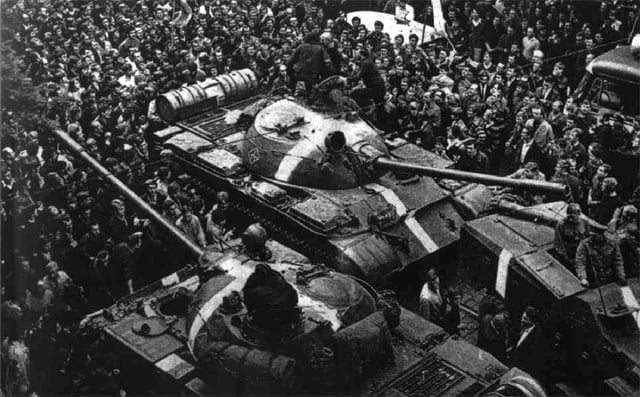
Soviet tanks, marked with white crosses to distinguish them from Czechoslovak tanks,[56] on the streets of Prague during the Warsaw Pact invasion of Czechoslovakia, 1968
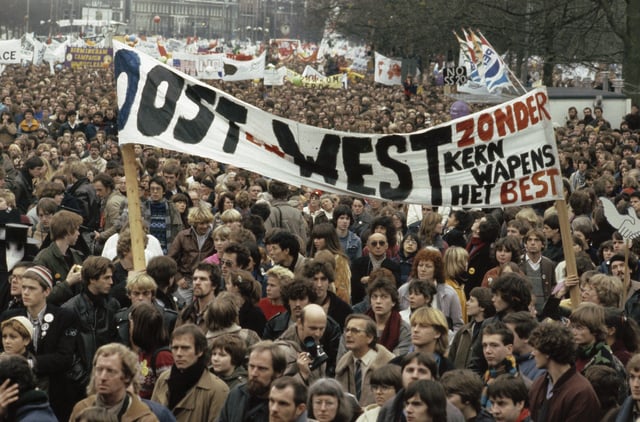
Protest in Amsterdam against the nuclear arms race between the U.S./NATO and the Warsaw Pact, 1981
For 36 years, NATO and the Warsaw Pact never directly waged war against each other in Europe; the United States and the Soviet Union and their respective allies implemented strategic policies aimed at the containment of each other in Europe, while working and fighting for influence within the wider Cold War on the international stage. These included the Korean War, Vietnam War, Bay of Pigs invasion, Dirty War, Cambodian–Vietnamese War, and others.[57][58]
The multi-national Communist armed forces' sole joint action was the Warsaw Pact invasion of Czechoslovakia in August 1968.[61] All member countries, with the exception of the Socialist Republic of Romania and the People's Republic of Albania, participated in the invasion.[62] The German Democratic Republic provided only minimal support, however.[62]
End of the Cold War
In 1989, popular civil and political public discontent toppled the Communist governments of the Warsaw Treaty countries. Independent national politics made feasible with the perestroika and glasnost policies induced institutional collapse of the Communist government in the USSR in 1991.[63] From 1989 to 1991, Communist governments were overthrown in Albania, Poland, Hungary, Czechoslovakia, East Germany, Romania, Bulgaria, and the Soviet Union.
On 25 February 1991, the Warsaw Pact was declared disbanded at a meeting of defence and foreign ministers from remaining Pact countries meeting in Hungary.[64] On 1 July 1991, in Prague, the Czechoslovak President Václav Havel[65] formally ended the 1955 Warsaw Treaty Organization of Friendship, Cooperation and Mutual Assistance and so disestablished the Warsaw Treaty after 36 years of military alliance with the USSR.[65][66] The USSR disestablished itself in December 1991.
Central and Eastern Europe after the Warsaw Treaty
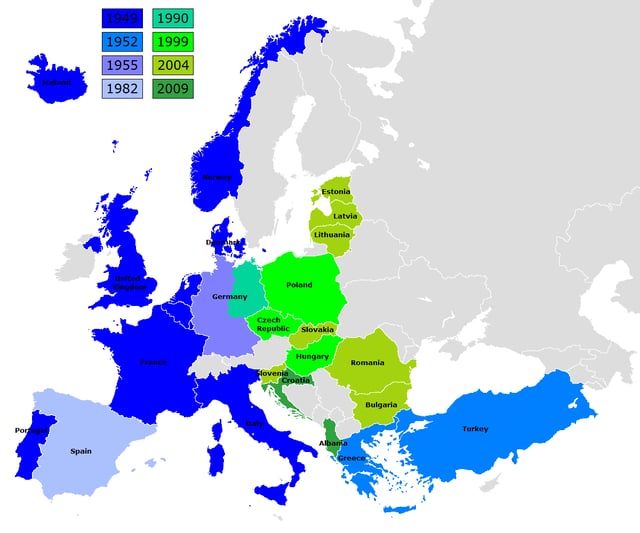
Expansion of NATO before and after the collapse of communism throughout Central and Eastern Europe
Russia and some other post-USSR states joined the Collective Security Treaty Organization (CSTO) in 1992, or the Shanghai Five in 1996, which was renamed the Shanghai Cooperation Organization (SCO) after Uzbekistan's addition in 2001.[69]
In November 2005, the Polish government[70] opened its Warsaw Treaty archives to the Institute of National Remembrance, which published some 1,300 declassified documents in January 2006. Yet the Polish government reserved publication of 100 documents, pending their military declassification. Eventually, 30 of the reserved 100 documents were published; 70 remained secret and unpublished. Among the documents published is the Warsaw Treaty's nuclear war plan, Seven Days to the River Rhine – a short, swift counter-attack capturing Austria, Denmark, Germany, and Netherlands east of the Rhine, using nuclear weapons, in self-defence, after a NATO first strike.[71] The plan originated as a 1979[72] field training exercise war game and metamorphosed into official Warsaw Treaty battle doctrine, until the late 1980s – which is why the Polish People's Republic was a nuclear weapons base,[73] first, to 178, then, to 250 tactical-range rockets, though these numbers may differ. Doctrinally, as a Soviet-style (offensive) battle plan, Seven Days to the River Rhine gave commanders few defensive-war strategies for fighting NATO in Warsaw Treaty territory.[71][74]
See also
Collective Security Treaty Organization (CSTO) – Modern military alliance between six former Soviet states.
Shanghai Cooperation Organization (SCO) – Modern Eurasian political, economic and military organization.
